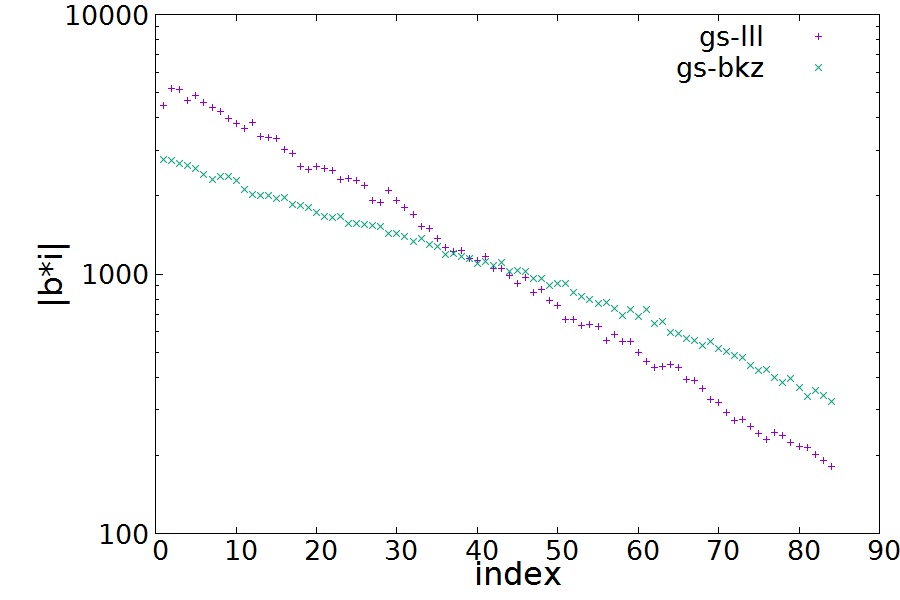Example codes
To use our library, please include the header: #include <lattice/pbkz.hpp>.Data structure for integer lattices
Our library manipulates integer lattice bases by the type LatticeBasis<T> where T is the type to representthe Gram-Schmidt coefficients. LatticeBasis
For your matrix L of mat_ZZ type, you can subsitute it as:
mat_ZZ L;
int dim=50;
L.SetDims(dim,dim);
/* Set an example q-ary lattice */
for (int i=0;i<dim;i++) {
for (int j=0;j<dim;j++) {
if (i==j) {
if (i<dim/2) L[i][j] = dim;
if (i>=dim/2) L[i][j] = 1;
}
if ((i>=dim/2) && (j<dim/2)) L[i][j] = rand()%dim;
}
}
LatticeBasis<double> B;
B = L; //Subsisute your basis
cout << B << endl; //Display your basis
Example of output is here.
Gram-Schmidt orthogonalizations
After substitution, you can compute Gram-Schmidt coefficients of your basis by:
B.updateGSBasis(); //compute Gram-Schmidt
B.gs.displaymu(); //print mu_{i,j}
Example of output is here.
Note that the diagonal elements are |b*i|2.
LLL basis reduction
To find an LLL reduced basis, you cal call
/*U contains the unimodular matrix corresponding to basis transformation */
mat_ZZ U;
U.SetDims(dim,dim);
for (int i=0;i<dim;i++) U[i][i]=1; //Initialized by the identity matrix
double delta=0.99; //Reduction parameter
local_LLL(B,&U,delta);
cout << "B=" << B << endl; //Display reduced basis
cout << "U=" << U << endl; //Display transformation matrix
Example of output.
Generate (Ideal) SVP Challenge instances
If you want to generate several challenge instances, you can do the following.//Gram-Schmidt coefficients are computed in long double precision LatticeBasis<long double> lB; int dim=100; //Dimension of challenge instance int seed=0; //Seed of challenge instance lB = svpc::getbasis(dim,seed); //Call the generator BigLLL(lB.L,0,0.999,VL1); //Call LLL subroutine having huge elements cout << lB << endl; //Display the LLL reduced basisExample of output.
Note that we call BigLLL() instead of local_LLL because SVP challenge instances are given by Hermite normal forms and they have huge elements.
You can use the function that computes the LLL basis directly:
lB = svpc::getlllbasis(dim,seed);Also, to generate instances of Ideal Lattice Challenge, you can call the generator as
vec_ZZ phi; //Array to contain the cyclotomic polynomial int index = 172; //Index of challenge instance int seed=0; lB = isvpc::getlllbasis(index,seed,phi); cout << "Lattice Dimension: " << lB.dim << endl;
Progressive BKZ reduction
If you want a reduced basis stronger than LLL, you can use the progressive BKZ subroutine. For the basis above, call the subroutine as
int beta=60; //Target BKZ level
int vl=VL1; //Display small amount of information
std::string stringoption=""; //No specific options
lB.updateGSBasis(); //Before output, need to update GS basis
lB.gs.gslentofile("gs_lll.txt"); //Output Gram-Schmidt lengths to file
ProgressiveBKZ<long double>(lB,U,beta,vl,stringoption);
lB.gs.gslentofile("gs_bkz.txt"); //Output Gram-Schmidt lengths to file
It outputs gs_lll.txt and gs_bkz.txt
which have |b*i| and |b*i|2 in the second and third columns, respectively.
Plotting the outputs, you can compare the Gram-Schmidt lengths of reduced basis as follows.

